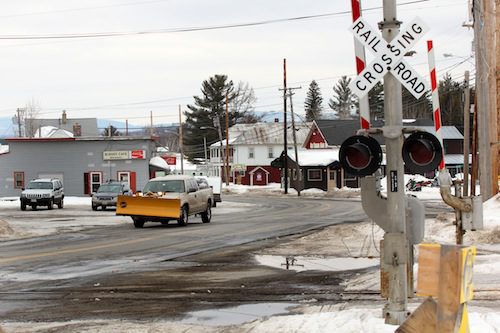Just as the state has revealed that crude oil shipments by rail have resumed along the state’s rail lines, Maine state emergency officials say new federal rules about shipping hazardous materials such as crude by rail don’t go far enough.
For example, the new rule does not apply to trains carrying less than a million gallons of crude or other material, yet such trains can cause explosions like the recent one in Lynchburg, Virginia.
On Wednesday, the state Department of Environmental Protection (DEP) said they have official reports of trains carrying crude resuming in March, after a four-month lull while crude was shipped by other means, mostly by sea or pipeline.
According to last Wednesday’s federal order, carriers must now tell state emergency response commissions the routes through which they will transport at least a million gallons of crude oil from the Bakken shale region of North Dakota, and estimate how many trains will travel, per week, through each county.

“It doesn’t help us with a mixed train, if it’s a train with other hazardous materials on it, or if there’s a train that doesn’t meet that million gallon threshold of 35 cars,” said Maine Emergency Management Agency director Bruce Fitzgerald, who called the order “a start.”
Each state has such commissions as part of the 1986 Emergency Planning and Community Right-To-Know Act, which requires federal, state and local emergency-planning and industry reports on how they store, use and release hazardous chemicals. Fitzgerald heads Maine’s commission, which began in 1987.
Since a crude-oil train disaster left 47 people dead in a Quebec village last July, trains carrying the crude oil have derailed and ignited in Virginia, North Dakota, Alabama and in the Canadian provinces of Alberta and New Brunswick.
The order, said Fitzgerald and other officials charged with coordinating emergency response in Maine, fails to answer practical questions about railroad accidents involving hazardous materials, like who will provide the needed equipment and manpower.
Though it encourages railroads to invest in training and resources for first responders like firefighters, “there’s no requirement there,” said Mark Hyland, the state agency’s director of operations and response.
By not addressing such issues, this burden remains with state, county and local officials, said Robert Gardner, technological hazards coordinator for the state agency. Safety officials’ best guess at what types of, and how much, hazardous materials are coming through Maine is reading the placard on a stopped train that indicates what it’s carrying.
“If a facility stores a certain amount of chemicals … we’d find out on annual reports if it’s in Maine,” said Gardner. “If a rail car or tractor trailer is going to Quebec from Massachusetts or from New Brunswick to New York, and they’re not stopping in Maine, we have no idea what those products are. Do they add to the problems that exist already? Or are they different chemicals that we don’t normally see in Maine?”
Gardner noted that when a train operated by Canadian National Railway ran aground 16 miles from Maine’s border in Plaster Rock, New Brunswick this January, five tank cars carrying crude oil and four carrying propane derailed and generated a four-day long fire and huge clouds of orange smoke.
“Trains carrying a smaller quantity wouldn’t fall under this executive order,” he said. A tank car typically carries 30,000 gallons of crude oil.
In the month of March, Pan Am Railways carried 15,545 barrels — or 652,890 gallons — of crude oil into Maine, according to Department of Environmental Protection records.
This is down from 385,566 barrels — or 16.2 million gallons — last March, and 70,484 barrels — 3 million gallons — reported last October, the last time Pan Am Railways reported carrying crude into Maine.
Railroads who transport crude or refined oil into the state are required to pay a monthly three-cent per barrel fee into the state oil spill clean-up fund.
In March 2013, 13 tank cars operated by Pan Am Railways derailed and spilled approximately one gallon of crude oil near the Penobscot River in Mattawamkeag.
The federal emergency order says “a pattern of releases and fires involving petroleum crude oil shipments originating from the Bakken and being transported by rail constitute an imminent hazard” as defined under federal code.
Chemicals that come through Maine include sulfuric acid and nitrous acid, according to Gardner.
Hyland said more notification of hazardous materials shipped by rail and better communications with railroads would help Maine emergency response officials better prepare for accidents.
“The communications part is something we’ve had a hard time with,” he said.
On Feb. 7, Fitzgerald sent a letter to Pan Am Railways asking for a list of the top 25 most hazardous materials they shipped through Maine in 2013.
In an email to the Maine Center for Public Interest Reporting, Fitzgerald said he spoke with a Pan Am Railways representative last week.
“They are reluctant to share information with us due to Freedom of Access laws in Maine,” said Fitzgerald, forwarding an August 2013 letter from the Department of Environmental Protection to Pan Am Railways. The letter addresses the company’s request to keep their oil transport records confidential for “security and competition” concerns.
“Our next step is to meet with the railroad in person to discuss our options for how they will share information with MEMA so that we can inform first responders,” said Fitzgerald, who said he hopes to have the meeting scheduled as soon as possible.
Cynthia Scarano, executive vice president at Pan Am Railways — one of the two railroads that have transported crude oil into Maine — did not respond to a request for comment.
Last August, the Association of American Railroads encouraged railroads to provide such information to emergency response agencies upon request, with the condition that officials do not share the list with the public.
Hyland said two emergency drills held in Lincoln this month and in Aroostook County last fall where railroads helped supply tank cars and locomotives are examples of “the kind of collaboration we want, training and exercises.” Pan Am Railways helped provide equipment at the drill in Lincoln, and New Brunswick Southern Railway, Eastern Maine Railway and Maine Northern Railway took part in the Aroostook County drill.
“We want to continue to work with the railroad and be collaborative with them, instead of it being another regulation or a requirement that’s put on them,” said Fitzgerald, adding that if not for the federal government’s order, “we wouldn’t be getting this information.”
The Department of Transportation also issued an advisory urging oil shippers to use tank cars with the “highest level of integrity available” to transport Bakken crude.
MEMA officials said they support phasing out the tank cars most often used to transport crude oil. The cars, known as DOT-111s, have faced criticism since the 1990s for being too prone to puncture.

Maine Municipal Association president Peter Nielsen has come out strongly against the federal advisory, saying it sidesteps “20 years of investigations and fact-finding about the rail cars.”
“We can follow our Canadian counterparts in banning unsafe DOT-111 tank cars, and others known for years to be unsafe in crash situations,” Nielsen said in a press release. “That we lag our Canadian counterparts is embarrassing. Previous efforts (U.S. and Canadian) were made to move forward in concert in improving rail safety, but the U.S.’ weak-kneed measures to date will allow unsafe, rolling stock to remain in service.”
Nielsen wrote to the White House on Monday urging the ban of unsafe tank cars.
Retrofitting the existing 300,000 DOT-111 tank cars in use could cost up to $1 billion and take years, according to industry estimates.
“It’s time for a thorough review of the U.S. tank car fleet that moves flammable liquids, particularly considering the recent increase in crude oil traffic,” Edward Hamberger, the Association of American Railroads president and CEO said last November, calling for the shippers and rolling-stock leasing companies who own the tank cars to phase out and retrofit their fleets.
Irving Oil Ltd. announced in February that by the end of last month, it would convert its fleet to meet U.S. federal standards for tank cars built after October of 2011.
Since last fall, lawmakers and safety advocates have been urging the federal agency responsible for setting such standards to pass new and higher standards. On April 30, the Pipeline and Hazardous Materials Safety Administration filed a notice of proposed rule-making, the next step in the often drawn-out process.







